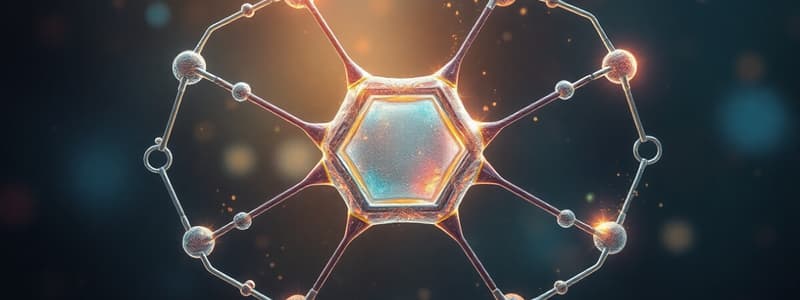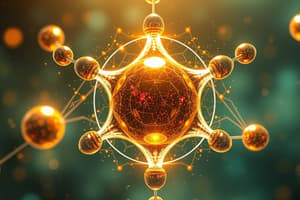Podcast
Questions and Answers
What is the bond angle associated with tetrahedral geometry?
What is the bond angle associated with tetrahedral geometry?
- 120°
- 180°
- 109.5° (correct)
- 90°
Which hybridization corresponds to a linear geometry?
Which hybridization corresponds to a linear geometry?
- sp2
- sp3
- sp (correct)
- s
Which of the following is a valid bonding option for carbon?
Which of the following is a valid bonding option for carbon?
- One double bond and one triple bond
- One triple bond and one double bond
- Three single bonds and one double bond
- One triple bond and two single bonds (correct)
What is the number of valence electrons that carbon has available for bonding?
What is the number of valence electrons that carbon has available for bonding?
What is the bond angle associated with trigonal planar geometry?
What is the bond angle associated with trigonal planar geometry?
In drawing a Lewis structure, what does a double bond represent?
In drawing a Lewis structure, what does a double bond represent?
Which statement accurately describes lone pairs of electrons?
Which statement accurately describes lone pairs of electrons?
Which geometry is associated with double bonds?
Which geometry is associated with double bonds?
What is the main effect of resonance on the stability of a structure?
What is the main effect of resonance on the stability of a structure?
Which rule states that the number of unpaired electrons must remain the same during resonance?
Which rule states that the number of unpaired electrons must remain the same during resonance?
What characterizes major resonance structures?
What characterizes major resonance structures?
In resonance drawings, what is indicated by arrows?
In resonance drawings, what is indicated by arrows?
Which of the following elements is the most electronegative?
Which of the following elements is the most electronegative?
What typically occurs in minor resonance structures?
What typically occurs in minor resonance structures?
What does having fewer lone pairs in a resonance structure indicate?
What does having fewer lone pairs in a resonance structure indicate?
Which of the following conditions contributes to a lower energy resonance structure?
Which of the following conditions contributes to a lower energy resonance structure?
What is the first step in determining an atom's formal charge?
What is the first step in determining an atom's formal charge?
For oxygen, how many lone pairs are typically present?
For oxygen, how many lone pairs are typically present?
When converting a pair of bonding electrons into a bond representation, what is used?
When converting a pair of bonding electrons into a bond representation, what is used?
What does resonance in molecular structures indicate?
What does resonance in molecular structures indicate?
How many electrons are counted from the lone pairs for nitrogen?
How many electrons are counted from the lone pairs for nitrogen?
What is the formal charge of an oxygen atom in CO2 if it has 4 lone pair electrons and is involved in 2 bonds?
What is the formal charge of an oxygen atom in CO2 if it has 4 lone pair electrons and is involved in 2 bonds?
Which of the following statements about lone pairs is true?
Which of the following statements about lone pairs is true?
In the example of CO2, how many lone pairs are present on each oxygen atom?
In the example of CO2, how many lone pairs are present on each oxygen atom?
What is organic chemistry primarily the study of?
What is organic chemistry primarily the study of?
Which of the following statements is true regarding carbon?
Which of the following statements is true regarding carbon?
What are valence electrons?
What are valence electrons?
Why is carbon significant in organic chemistry?
Why is carbon significant in organic chemistry?
Which of the following does NOT describe the contributions of organic chemistry?
Which of the following does NOT describe the contributions of organic chemistry?
What defines a lone pair of electrons?
What defines a lone pair of electrons?
What is the primary focus of the first chapter in this study of organic chemistry?
What is the primary focus of the first chapter in this study of organic chemistry?
How is the octet rule relevant to organic chemistry?
How is the octet rule relevant to organic chemistry?
What is the suffix used when naming alkanes?
What is the suffix used when naming alkanes?
If a molecule has seven carbons in the longest chain, what is its main stem name?
If a molecule has seven carbons in the longest chain, what is its main stem name?
What is the first step in naming an alkane molecule?
What is the first step in naming an alkane molecule?
In a structure with four carbon atoms, which prefix corresponds to its name?
In a structure with four carbon atoms, which prefix corresponds to its name?
What is the correct order for numbering the carbon chain when encountering branches?
What is the correct order for numbering the carbon chain when encountering branches?
Which of the following is not a main stem name for an alkane based on the number of carbons?
Which of the following is not a main stem name for an alkane based on the number of carbons?
What total number of carbons must be present in a molecule for it to be named 'Pentane'?
What total number of carbons must be present in a molecule for it to be named 'Pentane'?
When two branches are of equal size at the same point, how should numbering proceed?
When two branches are of equal size at the same point, how should numbering proceed?
Flashcards are hidden until you start studying
Study Notes
Introduction to Organic Chemistry
- Organic chemistry (Orgo) studies the molecular structure and reactions of carbon-containing compounds relevant to living matter.
- Carbon's atomic number is 6, with an electron configuration of 1s²2s²2p².
- Valence electrons are the outermost electrons involved in bonding. Lone pairs are valence electrons not involved in bonding.
Drawing Organic Molecules
- Bonds are depicted using lines in various notations: condensed formula, conventional structural drawing, and line-angle formula.
Molecular Orbitals, Hybridization, and Geometry
- Subshells and atomic orbitals influence molecular geometry.
- Hybridization (sp, sp², sp³) determines molecular geometry (linear, trigonal planar, tetrahedral) and bond angles (180°, 120°, 109.5°).
- Sigma (σ) and pi (π) bonds are formed through orbital overlap.
Lewis Structures, Formal Charge, and Resonance Structures
- Lewis structures represent electron distribution using dots and lines to depict bonds and lone pairs.
- Formal charge calculation involves summing lone pair electrons and half the bonding electrons, then subtracting from the atom's group number.
- Resonance structures show electron delocalization within a molecule, with the actual structure being an average of these contributors. Major resonance contributors are more stable (more octets, bonds, fewer lone pairs, least charge separation).
Basic Naming of Alkanes
- Alkanes are hydrocarbons with only single bonds.
- Naming alkanes involves identifying the longest carbon chain (stem), numbering carbons from the end closest to a branch (or the largest/closest branch), and adding prefixes (meth-, eth, prop-, etc.) based on chain length, with"-ane" suffix indicating an alkane.
Functional Groups
- Functional groups are specific groups of atoms within molecules that determine chemical properties. The provided text lists various functional groups but doesn't detail their individual characteristics.
Studying That Suits You
Use AI to generate personalized quizzes and flashcards to suit your learning preferences.




